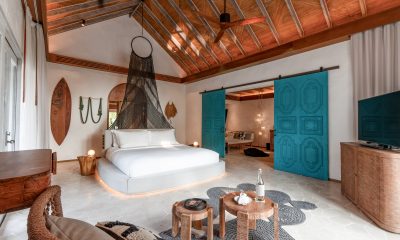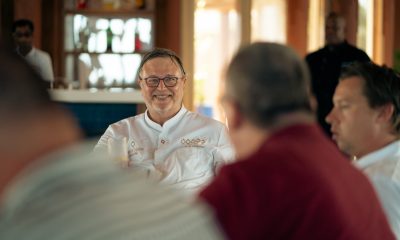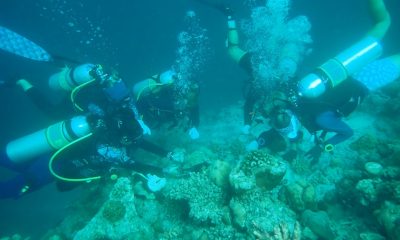Action
Major study shows resilience of Maldives reefs

US-based research group Coral Reef CPR, which has been studying a multitude of locations throughout the Maldives, has reported that some regions have demonstrated a remarkable resilience to elevated water temperatures, whereas others have been subjected to stress from other causes.
Bleaching in the Maldives was first reported in 2015, but most areas rebounded quickly. As the unusual weather patterns associated with an El Niño event persisted throughout 2015 and worsened in 2016, reefs bleached again. Coral Reef CPR measured the temperatures at a depth of 10 metres in lagoon, channel and outer reefs on Baa atoll and South Male Atoll, and found them to be abnormally high and steadily increasing between March and April that year.

Radshoo Atoll showing a high coral cover in August 2016.
Temperatures on exposed outer reefs ranged from 32-33° C, while lagoon reefs climbed to 35° C and higher, which was 2-5° C above the normal annual maximum. Using a highly accurate Castaway CTD (hand-held, deployable temperature metre), the team also measured temperature profiles from the surface to 40 metres of depth which showed a complete breakdown of cooler deep currents and absence of a thermocline. They reported that at the same time, “the surface of the sea was like glass and the water was gin clear,” allowing for a greater penetration of harmful UV radiation. “Together,” wrote Dr Andrew Bruckner of Coral CPR, “these conditions were a recipe for disaster.”
According to their research, Coral Reef CPR found that bleaching of the most sensitive corals started in March 2016, and by mid-April entire shallow reef systems throughout the country were stark white. Some corals resisted bleaching initially, especially the massive boulder corals such as Porites, but the water continued to warm. By the time the summer monsoon finally kicked in during mid-May, nearly every coral was either fully bleached or a vivid fluorescent colouration (yellow, purple, red or blue) as the coral animal produced photo-protective pigments to shield its tissue from too much sunlight.
Bleached coral can recover if environmental conditions return to normal relatively quickly, but the prolonged duration of the 2016 bleaching event overwhelmed many of the more sensitive species. Shallow lagoon reefs, reef flat and reef crest communities above five metres of depth sustained catastrophic losses, with up to 80 to 95 percent loss of coral in the hardest hit areas, particularly the dominant branching and table acroporids.
To gain more insight on the country-wide extent of bleaching impacts, Coral Reef CPR surveyed more than 80 reefs on eight different atolls in central and northern Maldives. While most emergent reefs in both fore reef and lagoon areas had become “a graveyard of coral skeletons” by August 2016, not all reefs were equally affected and even the hardest hit areas had survivors.

Acropora species at a ‘coral refuge’ in South Male, August 2017.
Pocillopora, another common form of branching coral, showed a higher survival rate in the shallow reef flats losing between 50 to 75 per cent of its cover – a large percentage, but significantly lower than other species. Other reefs throughout the country, especially those in outer exposed areas and submerged deep reefs which were dominated by massive boulder corals as opposed to the more fragile acroporids, lost between 10 to 20 percent of their corals, a much higher rate of survival.
Although initial observations suggested that the situation was ‘ominous’, Coral Reef CPR found that a more detailed examination of the reefs yielded a number of positive surprises. Of particular significance were individual colonies of certain species that failed to bleach, despite being located adjacent to other colonies that had fully bleached. Some of the corals produced vivid fluorescent pigments, which appeared to offer protection to these colonies.
The team found that some reefs provided a refuge from the bleaching, with high numbers of surviving corals on channel reefs and submerged reefs, known locally as thillas, where there is much more water movement. Coral mortality was also found to be reduced on outer reefs that are exposed to high wave action. These areas still lost most of their branching and table corals, but they are dominated by boulder corals, especially massive Porites corals which are much slower-growing and tend to be long-lived, with some colonies estimated to be between 500 and 1000 years in age. Although many of these larger corals appeared to lose some tissue, very few of them actually died, and the team began to see signs of tissue recovery, observing that all the reefs considered to be bleaching “refuges” had high numbers of boulder corals as well as the more fragile branching and plating acroporids.
Many of the Maldives’ atolls, especially on their western side, have small islands that contain their own lagoon, forming a structure that resembles a micro-atoll. These lagoons tend to be fairly shallow at only 5-15 metre deep, and the sandy bottom is covered with hundreds of small coral bommies and patch reefs. These areas often support unique, unusually large boulder, plating or foliaceous (leaf-like) corals that form the framework of the reef and are colonised by a high diversity of corals, especially acroporids. Within these areas, Coral Reef CPR identified more than 30 species of Acropora that survived the 2016 bleaching event. These environments tend to have lower visibility, which may explain why they provided a refuge from bleaching.

Baa atoll house reef with good coral cover despite being less than one metre deep.
In all reef environments, the team found much higher survivorship of corals on reef slopes. In many cases, the steep part of the slope was littered with hundreds of broken Acropora branches, fragments that had been detached from larger colonies on the top of the reef and carried down the slope. The base of these reefs contained larger, intact, branching, digitate (finger-like) and table acroporids in good condition.
Remarkably, the studied sites had unusually high numbers of coral recruits and one to two-year-old juvenile corals that had resisted bleaching. These included most of the acroporids and other species that sustained very high mortality during the 2016 bleaching event. Dr Bruckner notes that the presence of these corals provides evidence that coral reefs in the Maldives are still very resilient and are likely to recover quite quickly.
“Reading some of the recent negative reports from the Maldives highlights some of the gaps in understanding, variations between reef survey techniques and importance of evaluating a large number of reefs and not drawing conclusions from a small sample size,” reports Dr Buckner.
“This is particularly important as the geological foundation of the islands and reef systems of the Maldives does not permit small sample sets of data to be extrapolated for the whole country.”

Photographed in August 2017, this several centuries old Porites shows 100 percent live coral.
The Maldives contains a large number of reefs which are distant from populated areas. However, there is a great deal of concern regarding environmental degradation associated with a recent “building boom” around the islands. The team also found that other reefs, especially those around North Male Atoll and Ari Atoll have been badly damaged by a severe outbreak of Crown of Thorns Starfish (COTS), cushion starfish (Culcita sp.) and coral-eating snails (Drupella sp.). This outbreak of “corallivores” began prior to the bleaching event in 2016 and has continued after the bleaching ended, causing the loss of coral to be misinterpreted, according to Coral Reef CPR.
“During 2017,” writes Dr Bruckner, “a number of other marine biologists told us about reefs that are undergoing bleaching again. However, when we examined these locations, the damage caused by the corallivores was misinterpreted as bleaching and, further, our temperature meters and NOAA satellite data have recorded temperatures that are within the normal range.”
Noting that some observations may have been carried out with non-scientific equipment, he adds that “we strongly discourage the use of recreational diving computers as a measure of accurate water temperature.”
In conclusion, Dr Bruckner writes that “there have been large scale changes to the reef systems throughout the country as a result of the 2016 coral bleaching event, and these have been compounded locally by other human and natural stressors. However, these reefs show multiple signs that indicate they are resilient to these stressors, and in absence of high numbers of corallivores and unsustainable coastal development and other human impacts, they are undergoing rapid recovery.”
Photos: Coral Reef CPR
Action
Denise Höfer returns to The Nautilus Maldives for four-day padel programme in March 2026

The Nautilus Maldives is set to welcome back Denise Höfer, Germany’s No. 1 padel player and a leading global ambassador of the sport, for a renewed edition of its Masters for Masters series, taking place from 25 to 28 March 2026. This four-day programme invites families, couples and players of every level to discover Padel as a joyful shared adventure, guided by one of the world’s most inspiring Padel athletes.
Padel has grown into a worldwide phenomenon, celebrated for its accessibility and its ability to bring people together. Fast, intuitive and inherently social, it is the perfect sport for parents and children, partners and friends. With its playful nature and quick learning curve, Padel creates rare moments where beginners and seasoned players can genuinely enjoy the game side by side.
In this spirit, The Nautilus presents a Padel Masterclass shaped by connection. Whether learning your first rally with your partner, watching your children gain confidence on the court, or joining a spirited group session with fellow travellers, the programme transforms play into an experience of shared joy and discovery.
Guests will train with Denise Höfer across a curated line up of classes. Tailored, on-demand experiences including Couples Escape, Family Fun, Cardio Padel and Padel × Wellness invite guests to hyper-personalise their journey, blending movement with mindfulness, and performance with light hearted enjoyment. Complimentary daily sessions feature a Group Masterclass and a Children’s Masterclass, each thoughtfully crafted to suit different learning styles and skill levels.
After energising mornings on the court, guests can retreat to Solasta Spa for treatments inspired by natural flow and deep release. Personalised massages, stretching rituals and ocean-influenced therapies provide a gentle counterbalance to the day’s activities, inviting both body and mind to settle into a state of restoration. The experience becomes a soothing rhythm of movement, rest and reconnection, perfectly aligned with the private island’s unhurried philosophy.
With just 26 ultra-luxury houses and residences in the Baa Atoll UNESCO Biosphere Reserve, The Nautilus offers the ideal setting for meaningful time together. Days unfold freely, guided not by schedules but by the simple desire to savour each moment. Whether learning a new skill as a family, sharing a playful match at sunset, or cheering one another from the sidelines, every experience becomes part of a memory shaped by spontaneity and warmth.
The Padel Masterclass with Denise Höfer invites guests to discover more than technique. It offers a chance to bond, to grow and to reconnect with the joy of learning something new together. At The Nautilus, this journey is shaped not by rules, but by the freedom to follow your own rhythm.
Denise Höfer, Germany’s No. 1 Padel Player, shares: “I’m thrilled to be returning to The Nautilus for this special edition of its Masters for Masters series. The Nautilus’s Padel court is truly one of my favourites in the world: it’s incredible setting and stunning lagoon views create an atmosphere unlike anywhere else. I can’t wait to share this unique experience with The Nautilus guests once again.”
Adan Gomez, General Manager of The Nautilus Maldives, adds: “We are delighted to welcome Denise Höfer back to our shores. Having an athlete of her talent and success return to our island is a true honour and offering our guests the rare opportunity to train with her makes this event genuinely exceptional.”
Event Details:
- Dates: 25 to 28 March 2026
- Location: The Nautilus Maldives
To learn more about Denise Höfer and this exclusive experience, please visit the resort’s website. To book your stay, please contact hello@thenautilusmaldives.com
Action
Siyam World achieves snorkelling world record with 307 participants

Siyam World Maldives has officially made global history. On December 5th, the island pulled off one of its boldest ideas yet, becoming the first resort on the planet to earn a Guinness World Records title for The Most People Snorkeling Simultaneously at a Single Venue. In partnership with Freedive Maldives, Siyam World rallied an incredible 307 snorkelers from guests, neighbors, and ocean lovers across the region, diving past the required 250 participant mark and turning the house reef into a spectacular sea of fins and fun. Guinness World Records officials flew in to verify every detail, and for the first time ever in the Maldives, every participant received an official Guinness World Records medal, making “Snorkel World 300” a milestone etched not only in record books but also in everyone’s memories.
The energy of the day embodied everything Siyam World stands for — a big, bold, anything-is-possible playground where imagination meets island life. The event was more than a record attempt; it was a celebration of marine life, community connection, and Siyam World’s adventurous DNA. The event aligned with Sun Siyam Resorts’ ongoing sustainability initiatives, encouraging guests and locals alike to appreciate and protect the natural beauty of the Maldives’ underwater world. It also served as a proud moment for the destination. As the first Guinness World Records medal ceremony ever held in the Maldives, the event spotlighted Maldivian hospitality, creativity, and ocean culture on a global stage.

“What a moment. Being the first resort in the world to set a Guinness World Records title is something we will always carry with pride, not just for Siyam World and Sun Siyam Resorts, but for the Maldives as well. We have never been the type to follow the usual path; doing the unexpected has always been our style. A huge thank you to everyone from the nearby islands who came together to make this possible,” said Ausy Waseem, Resort Manager, Siyam World.

If any resort was going to break a world record, it was always going to be Siyam World. From adrenaline-fueled adventures to quirky island experiences that spark global attention, Siyam World has earned its reputation as the Maldives’ most unrestrained, maximalist playground. This Guinness World Records title adds yet another chapter to its growing list of “only-at-Siyam” moments, proof that the resort is not just a place to stay, but a destination where the extraordinary is the everyday.
Siyam World now stands proudly as a Guinness World Records titleholder, an extraordinary accomplishment shared with the Maldives and the global travel community.
Featured
World-first overwater padel tennis court launched at Meyyafushi Maldives

Meyyafushi Maldives, a new five-star premium all-inclusive boutique resort, has introduced what it describes as a world-first in resort recreation: a fixed overwater padel tennis court. Positioned above clear lagoons and framed by sweeping sunset views, the court offers guests an opportunity to play and unwind in a distinctive setting surrounded by panoramic ocean vistas.
Located in the Lhaviyani Atoll, the overwater court allows players to take part in a match while immersed in the natural calm of the surrounding seascape. Guests staying at the resort are offered one hour of complimentary padel tennis as part of the premium all-inclusive package. The setting provides a secluded and tranquil space for both beginners and experienced players to practise with the sound of the ocean beneath.
“Padel tennis has become one of the fastest-growing sports in the world, and we wanted to bring it to life in the most spectacular way possible,” said Ahmed Siaar, Cluster General Manager of BeKind Hotels & Resorts. “Playing on water, surrounded by endless blues, transforms the game into something transcendent – it’s active luxury at its finest.”
The overwater court forms part of Meyyafushi’s wider range of facilities, which include an underwater dining restaurant, an overwater wine cellar, water pool suites with slides, a mini bowling lane, and an adults-only sky bar featuring a glass-bottom infinity pool. Each facility has been created to offer experiences that encourage connection, exploration and wellbeing.
With uninterrupted sunset views and a distinctive overwater location, Meyyafushi Maldives’ padel tennis court marks a global first for the sport, bringing together physical activity, landscape and design in a single setting.
-

 Drink1 week ago
Drink1 week agoFelice Capasso brings award-winning mixology to The St. Regis Maldives Vommuli this February
-

 Drink1 week ago
Drink1 week agoSun Siyam Olhuveli unveils Milano, Olive Bar and Crust & Flame on Dream Island
-

 Featured1 week ago
Featured1 week agoKuramathi Maldives announces private wellness programmes with Imron Zulfikar
-

 Entertainment1 week ago
Entertainment1 week agoHulhule Island Hotel names 2ofus as New Year’s Eve 2026 headline act
-

 Featured1 week ago
Featured1 week agoSpring reawakens: Sirru Fen Fushi showcases Maldives at its calmest
-

 Cooking5 days ago
Cooking5 days agoThe St. Regis Maldives Vommuli Resort welcomes Chef Renzi Gianluca for Tastemaker series collaboration
-

 News1 week ago
News1 week agoThe Standard, Maldives achieves Green Globe Certification after rigorous audit
-

 Cooking1 week ago
Cooking1 week agoChef Frank Fol leads plant-based culinary programme at ananea Madivaru Maldives















